Adjective - 2 | English Grammar Basic - Class 10 PDF Download
Understanding Degrees of Comparison
Degrees of Comparison refers to the way in which we compare the qualities of different nouns using adjectives. When we want to describe how one noun's quality is different from another's, we change the form of the adjective.
Example Sentences:
- Sunil’s orange is sweet.
- Kavita’s orange is sweeter than Sunil's.
- Sanjay’s orange is the sweetest of all.

Explanation:
- In the first sentence, "sweet" is a simple adjective that describes Sunil's orange.
- In the second sentence, "sweeter" compares Kavita’s orange with Sunil’s orange, showing that Kavita's orange has more sweetness.
- In the third sentence, "sweetest" shows that Sanjay’s orange has the highest degree of sweetness among all.
These sentences demonstrate the three degrees of comparison:
- Positive Degree: Describes a quality without comparison (sweet).
- Comparative Degree: Compares the quality between two items (sweeter).
- Superlative Degree: Shows the highest degree of quality among three or more items (sweetest).
Types of Degrees of Comparison
There are three kinds of degrees:
- Positive Degree: This degree describes a quality without making any comparison. For example, "The orange is sweet." Here, the adjective "sweet" is used in its positive form to describe the quality of the orange without comparing it to any other orange.
- Comparative Degree: The comparative degree is used to compare the quality between two items. For instance, "Kavita's orange is sweeter than Sunil's." In this sentence, "sweeter" is the comparative form of the adjective, indicating that Kavita's orange has more sweetness compared to Sunil's.
- Superlative Degree: The superlative degree shows the highest level of quality among three or more items. For example, "Sanjay's orange is the sweetest of all." Here, "sweetest" is the superlative form, indicating that Sanjay's orange has the highest level of sweetness among all the oranges being compared.
Structures for Positive, Comparative, and Superlative Degrees
1. Positive Degree:
- Structure: No other + noun + is as + positive form of adjective + as + noun.
- Example: No other boy in our class is as bad as Mohan.
2. Comparative Degree:
- Structure: Noun + helping verb + comparative form of adjective + than any other + noun.
- Example: Mohan is worse than any other boy in our class.
3. Superlative Degree:
- Structure: Noun + helping verb + the + superlative form of adjective.
- Example: Mohan is the worst boy in our class.
Note: After "the" (superlative), "no other" (positive), and "than any other" (comparative), use a singular noun.
- Correct: The best boy, No other boy, Than any other boy.
- Incorrect: The best boys, No other boys, Than any other boys.
Structures with "Very few" and "One of"
1. Positive Degree:
- Structure: Very few + plural noun + are as + positive form of adjective + as + noun.
- Example: Very few cities of India are as busy as Kolkata.
2. Comparative Degree:
- Structure: Noun + helping verb + comparative form of adjective + than most other + plural noun.
- Example: Kolkata is busier than most other cities of India.
3. Superlative Degree:
- Structure: Noun + helping verb + one of the + superlative form of adjective + plural noun.
- Example: Kolkata is one of the busiest cities of India.
Note: After "one of," "very few," and "than most other," use a plural noun.
- Correct: One of the best girls, Very few girls, Than most other girls.
- Incorrect: One of the best girl, Very few girl, Than most other girl.
Summary
- Positive Degree: Describes a quality without comparison.
- Comparative Degree: Compares the quality between two nouns.
- Superlative Degree: Shows the highest degree of quality among three or more nouns.
Examples:
- Positive: No other city is as beautiful as Paris.
- Comparative: Paris is more beautiful than any other city.
- Superlative: Paris is the most beautiful city in the world.
Degrees of Comparison Chart
Here are the degrees of comparison chart organised into proper tables:
Type 1: One-Syllable Adjectives with Doubled Final Consonants
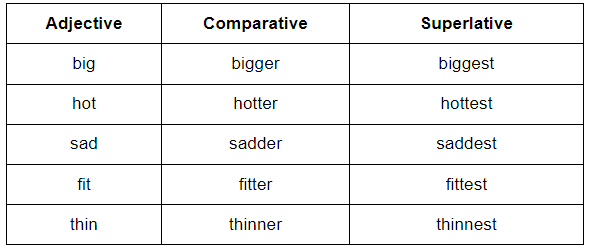
Type 2: One-Syllable and Some Two-Syllable Adjectives with Regular Formation
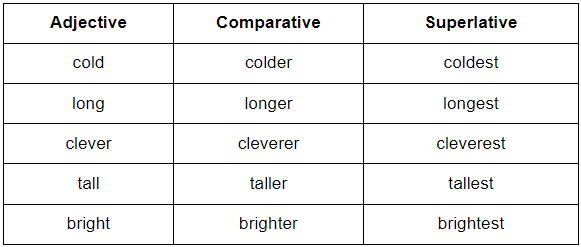
Type 3: Two-Syllable Adjectives Not Ending in 'y'
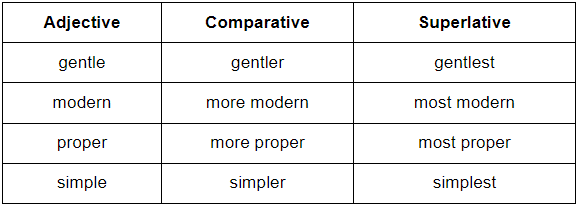
Type 4: Two-syllable adjectives Ending in 'y'
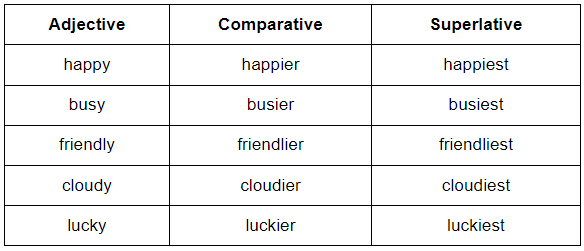
Type 5: Multi-Syllable Adjectives Using "More" and "Most"
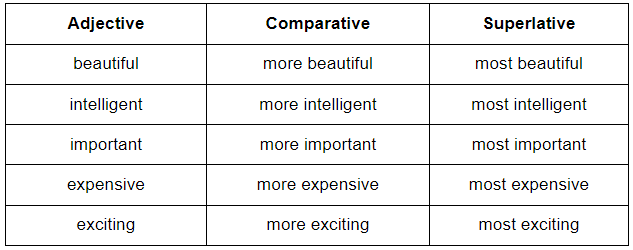
Type 6: Irregular Adjectives with Unique Forms
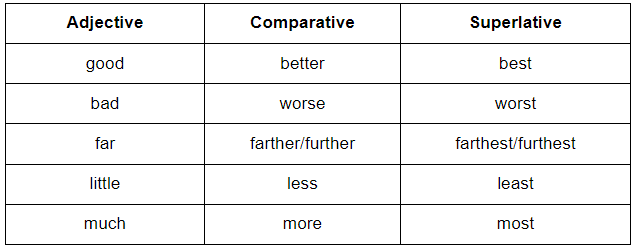
Above charts break down the formation of comparative and superlative forms for each type of adjective.
|
20 videos|143 docs|18 tests
|
FAQs on Adjective - 2 - English Grammar Basic - Class 10
| 1. What are the three degrees of comparison for adjectives? |  |
| 2. How do you form the comparative and superlative degrees of adjectives? |  |
| 3. Can you provide examples of adjectives in all three degrees of comparison? |  |
| 4. Are there any irregular adjectives in the degrees of comparison? |  |
| 5. How can degrees of comparison enhance writing and communication? |  |
















